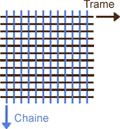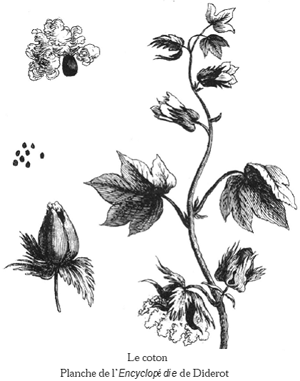Help
The purpose of this area of our site is to give you an introduction – and, above all, a better understanding – of the world of made-to-measure clothing and, in particular, the fabrics that we use to create our shirts.
Who’s never come across references to twill, Oxford weave or popelin? Who’s never heard a fabric being referred to as excellent quality on the basis that it’s a super 120? In short, a certain number of terms are in common use without their meaning necessarily being understood. We’re going to try and shed a little light on the subject for you.
First of all, you need to understand the basics, namely the different types of weave that are available.

The weave is the interlacing of warp and weft threads to make up the fabric. The warp thread is the vertical thread and the weft thread is the horizontal thread, as shown in the diagram below.
There are three types of weaves: twill, satin and plain weaves. All other weaves are a subset of these.

Twill weaves feature diagonal lines known as wales. These diagonal threads are obtained by passing the warp thread alternatively below a weft thread, then above two weft threads. This ratio can be modified depending on the desired outcome. For example, if a fabric is formed from 3/1 twill, it means that, out of every four threads, only one binds the weft.
This weaving technique creates flexible, easy-to-hang fabrics such as gabardine or herringbone cloth.

Plain weave is the simplest of all. Each weft thread passes alternately above, then below each warp thread. This technique results in fabrics that don’t hang as well as twill fabrics, such as flannel, taffeta, poplin, or zephyr.

Satin weave results in a solid, homogenous fabric due to the predominance of a warp or weft thread. This results in fine fabrics that are lustrous and shiny on the front with a matte finish on the reverse. Pronounced diagonal effects are avoided altogether, due to the reduction in the number of thread tucks in the fabric. This technique produces fabrics that are easy to hang and flexible, such as damask or sateen.
Natural, raw cotton fibres lack both resistance and strength. They are twisted together to obtain a continuous, resistant yarn. The result varies depending on the nature of the cotton used, the way it is prepared (carded or combed fibre) and the degree to which the yarn is twisted.
Cotton is a plant fibre that surrounds the seeds of the cotton plant (Gossypium), a shrub of the mallow family. This fibre is generally transformed into yarn, which is then woven to create fabrics. Cotton is the most widely produced natural fibre worldwide. Gossypium is a shrub in the Malvales order, and ten different species are cultivated worldwide.
Fibre lengths can vary as follows:
The length of ELS quality fibres gives the lightness, softness and strength that are necessary to create the most beautiful and finest fabrics. This quality of cotton represents only 3% of worldwide production, and two thirds of this cotton is produced in Egypt, which is why Egyptian cotton has such a good reputation. Nonetheless, this cotton represents only a quarter of Egypt’s total cotton production.
Generally speaking, cotton production requires relatively little water, but lots of heat and light. For this reason, cotton only blooms in equatorial regions between the 37th northern parallel and the 32nd southern parallel, in over ninety countries, but just four of those countries account for 70% of worldwide production, namely China, the United States, India, and Pakistan.
Carding: this involves disentangling and aerating the fibre. The yarn that results is supple, smooth, light, and fluffy, but relatively fragile.
Combing: Combing is an additional stage added to the manufacture of cloth with a view to eliminating the shortest fibres and retaining only the longest ones. This option also removes air that is trapped between the fibres. The resulting yarn is smooth and bright, strong but not as soft.
The twist of a thread is the direction in which the yarn was spun or twisted.
There are two types of yarn twists, which depend on the direction in which the fibres are spun: Z twist and S twist (see the illustration). Two or more threads can be combined – this is known as the ply of the thread. This results in a thicker, more consistent, and more robust thread. Generally, a single-ply thread is spun in a Z shape and multi-ply threads are spun in an S shape.
Z TWIST: the thread is spun clockwise;
S TWIST: the thread is spun anti-clockwise.
Threads are spun together, to give multi-ply threads, in the opposite direction from which they were spun.
There are several different types of thread, made up from a number of different strands. The two main types are as follows:
The thread count measures the number of warp and weft threads in a square inch (6.45 square centimetres) of fabric. The thread count also depends on the weave and the quality of the fibre. When threads are finer, as with Egyptian cotton, more threads can be woven per square inch, resulting in a finer fabric.
The cotton count is a measurement that allows you to analyse the fineness of the thread used in the manufacture of the cloth. This number can be expressed in many ways, and the cotton count is the number of hanks (840 yards or 768.1m) of skein material that weigh 1 pound (453.6 g).
For example, if I take a yarn with a 120 cotton count, this means that there would be 92,172 metres of thread contained in one pound (120×768.1). Logically, the finer the thread, the less it will weigh, and therefore the greater the length contained in a pound of yarn and thus the higher the cotton count.
Conversely, if you consider a thicker thread with 38,450 metres weighing 453.6 g (i.e., one pound) you can deduce that its cotton count is 50 (38405/768.1).
In summary, the higher the number, the finer and lighter the material, with good quality materials starting at 90 and upwards. At 120 or above, you can be sure of a very high quality fabric. Be careful nevertheless as, above a cotton count of 160, the fineness of the threads makes your shirts much easier to crease, but nevertheless much more pleasant to wear and longer-lasting.
N.B.: ready-to-wear shirts generally uses fabrics with cotton counts between 80 and 100.

Sources: memotextile.free.fr / Eric Orsenna - Voyage aux Pays du Coton (“A Journey to the Lands of Cotton”) / IFTH / www.spinningtheweb.org.uk